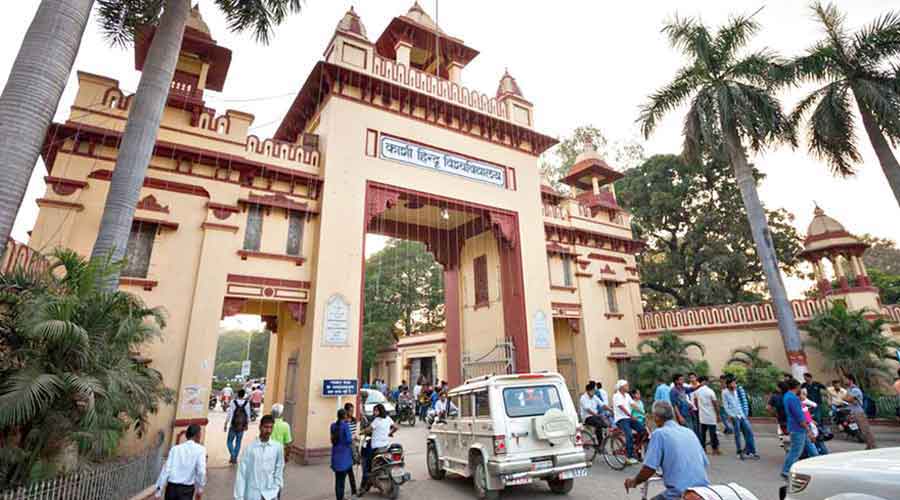Two central universities have launched a first-of-its-kind master’s programme in “Hindu Studies” that projects the caste system as inclusive, seeks to counter “negative” interpretations of Hindu theory and practice by foreign scholars, and appears to present Buddhism and Jainism as branches of Hinduism.
Banaras Hindu University developed the curriculum, which has been adopted also by the Shri Lal Bahadur Shastri National Sanskrit University, Delhi.
While these two institutions have introduced the programme from the current academic year — attracting 46 students including one from Trinidad and Tobago — JNU and the Central University of Gujarat are planning to launch it too, sources said.
“A student with an MA degree in Hindu Studies shall: 1. Develop a good understanding of foundational principles underlying Hindu civilisation, society, and culture. These principles provide a basis through which Hindus, despite the endless diversity present amongst them, can relate to each other…,” says the preamble to the syllabus for the course.
The programme also looks to remove “misconceptions” about the Sanskrit Shastras and Hindu society, said Sadashiv Dwivedi, coordinator of BHU’s Bharat Adhyayan Kendra (BAK) who helped design the course.
Dwivedi claimed the caste system was inclusive on the ground that “artistic skills like carpentry and jewellery making” were given to the Shudras. He cited the concept of “Ardhanarishvara, the Lord who is half-woman” as proof that the Hindu Shastras were gender-neutral.
An academic who did not wish to be quoted told The Telegraph that the programme was “an attempt to give an intellectual look and flavour to Hindutva and rationalise it”.
He said: “Although we cannot infer too many things from the syllabus, if it proliferates among institutions on a grand scale, Hindutva would be portrayed as Hinduism and the diversity and inclusiveness of Hinduism would be done away with.”
Y.S. Alone, a professor at JNU’s School of Arts and Aesthetics, and Pradeep Gokhale, former professor of philosophy at the Savitribai Phule Pune University, who have seen the syllabus, said it seemed to incorrectly appropriate Buddhism and Jainism under Hinduism.
They said the curriculum presented the three religions as though they were in agreement instead of adopting the more fruitful option of highlighting their differences for a more critical understanding of Hinduism.
Asked whether the programme projected Buddhism and Jainism as sects or branches of Hinduism, Dwivedi wrote back: “Branches of Hindu Dharma having common elements.”
He argued the course attempted to convey the “unity in diversity” among the three religions for the sake of “national unity”. While emphasising “differences in thoughts and principles (does) strengthen knowledge”, he added, it should not come “at the cost of dividing individuals”.
Among the key components of the course are: Tatva Vimarsh, “the study of the essence of every object in the world”; Dharma and Karma Vimarsh, “the study of the sustenance of humanity and concept of reality”; Praman Siddhanta, “the evaluation of the knowledge tradition”; Punarjanma Bandhan and Moksha Vimarsha, the study of rebirth and salvation; the Ramayan and the Mahabharat; and “Western methods of analysing knowledge”.
The course includes 16 papers, nine of them compulsory and seven elective. It has a core paper on the Sanskrit language.
There’s a wide choice for the elective papers: principles of Vedic/ Jain/ Bauddha traditions, Vedanga, the Pali/ Prakrit language and literature, Indian ethics, Natya, comparative religion, Purana Parichaya, Indian architecture, literary theory, (ancient) Indian military science, art, law and jurisprudence.
To enrol, a student needs to have earned a BA degree in any subject.
Dwivedi said the courses on Hindu religion and society taught at western universities like Cambridge or Harvard referred to secondary sources and distorted facts.
“The foreign universities do not go deep into the original sources. They highlight negative aspects, (claiming that) the Shastras are not viable for the unity of society or for upholding the dignity of women,” Dwivedi said. “This course will remove these misconceptions.”
Many Indian scholars too have highlighted what Dwivedi called “negative aspects”.
A study on “The Continuing Practice of Untouchability in India: Patterns and Mitigating Influences” by Amit Thorat from JNU and Omkar Joshi from the University of Maryland says: “The entire system of castes or the ‘super structure’ ideologically derives from the ‘Chaturvarnaya’ system or the four-fold division of society.
“This religious theory of the origin of society (cosmogony) derives from the 19th hymn of the tenth Mandala of the Rig Veda, the Purusha Shukta. This divides society into four ‘varnas’ or classes that are hierarchical in nature.”
The Purusha Shukta identifies the four castes with four body parts — mouth (Brahmins or priests), arms (Kshatriyas or warriors), thighs (Vaishyas or traders and merchants) and feet (Shudras, the workers and craftsmen).
The study says the Hindu scripture Manu Smriti codified the caste order, making the boundaries between them and practices such as endogamy more rigid. It gave the right to education and resources to the upper castes, forcing the Shudras and the outcastes or Ati Shudras to serve them. It portrayed women as properties of men in the family.
Dwivedi said the Purusha Shukta considered each body part as important, and therefore no hierarchy should be seen in the system of varna.
Gokhale, the retired philosophy professor, said the syllabus had skipped the reform movements within Hinduism.
“The syllabus presents a picture of everything being all right with Hinduism. The reform movements relating to patriarchy and caste should have been included,” he said.
“Second, Buddhism and Jainism have been projected as sects of Hinduism. If at all, Buddhism and Jainism can be included in the syllabus as a sort of criticism of Hinduism. Because of Buddhism, Jainism and the Saint movements, Hinduism underwent some changes.”
Alone, the JNU professor, said the Shraman Dharma of Buddhism and Jainism and the Brahman Dharma of Hinduism always existed as distinct traditions in ancient India. “Unlike Hinduism, Buddhism does not believe in the soul,” he said.
Alone said Brahminical Hinduism never advocated or practised equality. “Now too, the unequal social system is in practice in Hinduism.”
Dwivedi said the course did not “aim to establish the supremacy of Hindu thoughts but to project all (Hinduism, Buddhism and Jainism) as having the same origin and thus being united”.
In 2020, then BHU vice-chancellor Rakesh Bhatanagar had asked the BAK to prepare the syllabus. A taskforce of Dwivedi, Nachiketa Tiwari from IIT Kanpur, and Ram Nath Jha from the School of Sanskrit and Indic Studies, JNU, drew up the syllabus in consultation with BHU teachers.












